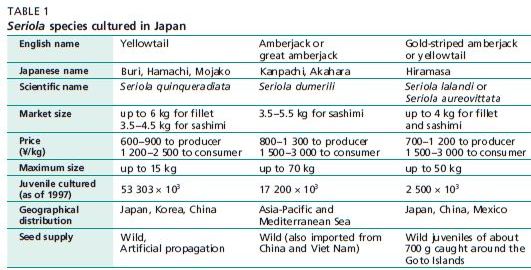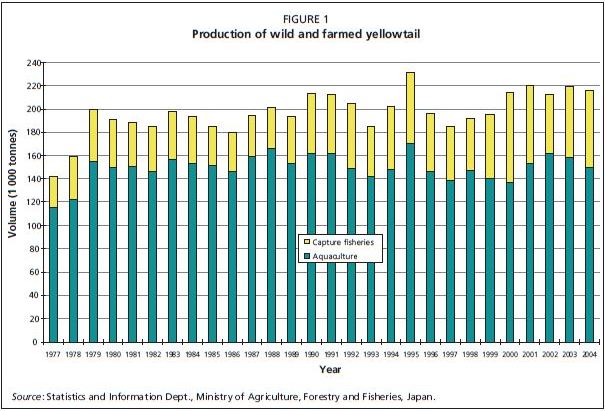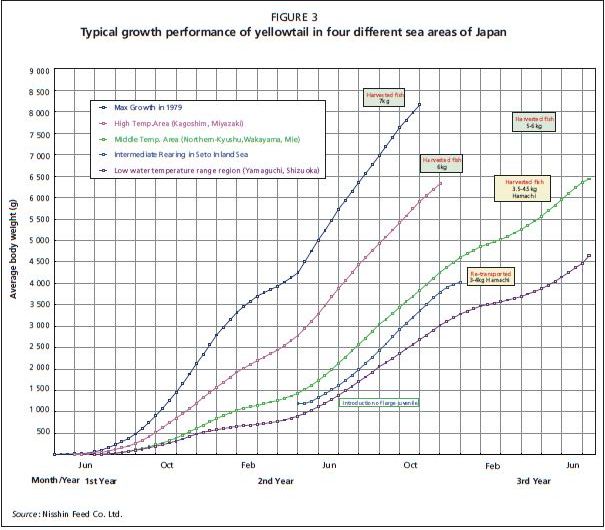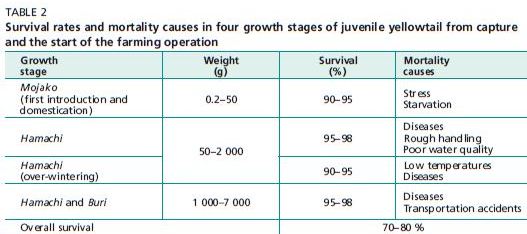DESCRIPTION OF THE SPECIES AND ITS USE IN AQUACULTURE
Life cycle and geographical distribution
The genus Seriola or yellowtail, a highly active fish belonging to the Carangidae family, is found in the Atlantic, Indian and Pacific oceans, with most species occurring in tropical and subtropical waters. A few species have global distribution (such as the amberjack, Seriola dummerili, and the Pacific yellowtail, Seriola revoliana) while others, such as the Japanese yellowtail, Seriola quinqueradiata, have a more limited regional distribution. Currently approximately 12 species of Seriola that have been described.
These fish are typically streamlined, elongated and laterally compressed. Larger members of the genus which are commonly cultured (i.e. the gold-striped amberjack, Seriola lalandi, and Seriola dummerili) may reach 200 cm in length and weigh up to 50–60 kilograms. Seriola spp. typically inhabit deep open waters often adjacent to
TABLE 1
Seriola species cultured in Japan

Source: Nisshin Feed Co. Ltd.
offshore islands or coastal areas where they may also be present in shallower areas. Their prey includes a variety of fish, squid and a number of crustacean species. In Japan, yellowtail spawn offshore from southern Kyushu to Chugoku off the Sea of Japan and then migrate north to Hokkaido where they reach sexual maturity in 3–5 years. Following this they migrate south again to spawn (Abe and Homma, 1997). Throughout the season, various sizes of yellowtail can be caught in different parts of Japan where special names are given to fish of different size (Suehiro and Abe, 1994). Migratory populations are differentiated by their growth rate and nutritional status (Abe, 1987). All juveniles weighing less than 50 g are called Mojako. Cultured yellowtail weighing <5 kg are called Hamachi, and those heavier than 5 kilograms are called known as cultured-Buri which are distinguished from the wild-Buri (Abe, 1986). All cultured Carangidae in Japan have different characteristics and require different culture methods as shown in Table 1.
Amberjack aquaculture has developed rapidly and the species rivals yellowtail in popularity. The amberjack meat maintains its brilliant colour and firm texture longer than that of the yellowtail and, due to its superior quality, it usually attains a much higher market price compared to cultured red seabream (Pagrus major), which is a highly valued fish species in Japan. Amberjack is distributed throughout the world and is a popular game fish in Hawaii (United States of America), Australia and in the Mediterranean Sea. This species grows faster and has a better feed efficiency than yellowtail at water temperatures higher than 17 ?C.
Capture fishery
Yellowtails of various sizes are harvested from many fishery grounds along the Japanese coast using several kinds of fishing techniques. In 1995, capture fisheries of yellowtail yielded around 61 666 tonnes, and aquaculture production yielded 170 312 tonnes, totalling 231 978 tonnes (Figure 1). In 2004, capture fishery landed 66 345 tonnes using different fishing gear including set nets (21 786 tonnes), round haul nets (18 876 tonnes), purse seines (11 581 tonnes), gillnets (6 006 tonnes) and other fishing techniques (8 096 tonnes). At present, wild yellowtail capture fishery remains stable whilst yellowtail aquaculture continues to increase.
Collection and culture of wild seed
After the wild Mojako juveniles are harvested, measured and the numbers recorded by the cooperatives, they are weaned on artificial feed and weak specimens discarded. As young yellowtail and related species are sensitive to food deprivation, cannibalism
FIGURE 1
Production of wild and farmed yellowtail

Source: Statistics and Information Dept., Ministry of Agriculture, Forestry and Fisheries, Japan.
may occur, particularly if the fish are kept in the holding tanks for long periods. Furthermore, if the young fish are not fed for more than three days they will usually fail to adapt to the artificial feeds.
In 1998, the Fisheries Agency of Japan imposed regulations limiting the number of Mojako that can be caught annually for use in aquaculture to approximately 25 million in order to ensure the sustainability of the fishery and to protect the resource. The Marine Aquaculture Association of Japan determines the fishing allocations made to each prefecture, while each prefecture decides on the fishing season and distribution of the fishing permits to the local Federation of Fisheries Cooperatives. In 1970, the number of Mojako caught was over 100 million individuals, however, over the past 30 years the harvest has fluctuated between 30 to 100 million, and dropped to 25 million in 1997 (Figure 2). Fish farmers were, however, able to maintain a total production level of about 150 000 tonnes despite the decrease. The highest production level was achieved in 1995 with 170 000 tonnes produced. More recently the domestic supply of Mojako showed a significant decrease, and a few million were imported from the Republic of Korea. Juvenile amberjack (Seriola dummerili) are usually caught with Mojako and at one time the two species were cultured together. However, due to the parasitic worm, Benedinia, often present on the amberjack, farmers prefer to raise the two species separately.
The current price of amberjack juveniles ranges from ?500–1 500 (US$4.8–14.3) for fish weighing between 50–600 g. The high price facilitated the commercial production of hatchery-reared juveniles. Japan has imported wild-caught juveniles from China and Viet Nam via China Hong Kong Special Administrative Region (SAR) since 1986.
Farmers prefer to use wild-caught seed over hatchery-produced seed as the latter are generally more expensive and are usually too small for successful rearing. In 2003, the Fisheries Agency of Japan succeeded in spawning and producing yellowtail seed larger than wild Mojako by controlling the water temperature and the photoperiod cycle of the broodstock. Unfortunately, however, the hatchery-produced seed had a high percentage of body deformity and mass seed production has not achieved mainly due to the difficulty in securing healthy broodstock.
FIGURE 2
Temporal changes in numbers of wild-caught and farm-raised yellowtail juveniles, 1977–2006

Source: Marine Aquaculture Association of Japan.
The typical growth performance of yellowtail in four different sea areas in Japan is shown in Figure 3. Depending on water temperature, Mojako
can usually be stocked from April through to July. In sub-tropical regions, such as Okinawa and Kagoshima, the average water temperature ranges from 20–24 ?C. This optimal temperature range for farming yellowtail is stable for >75 percent of the year and it is possible to obtain >6 kilogram yellowtail within
two years. In the Kyushu area, which includes Kumamoto and Nagasaki, the average annual water temperature ranges from 17–19 ?C. This temperature is optimal for yellowtail culture
FIGURE 3
for about 50 percent of the year and, due to the shorter culture

Source: Nisshin Feed Co. Ltd.
period when the temperature is optimal, over 70 percent of the yellowtail reared in this region are three years old at harvest. In the Honshu area, which includes Shizuoka and Yamaguchi, yellowtail can be farmed but the temperatures are not as favourable compared to the regions further south. The average annual water temperature is around 18–19 ?C, and more than three years are required to produce 6 kilogram fish. A specific feature of this region is its short autumn, which provides the fish with insufficient time to prepare for winter. If the fish are pushed to grow rapidly during autumn, high mortalities may occur in winter and early spring, therefore, fish weighing from 3.5 to 4.5 kilograms are produced for the sashimi market.
In the Seto Inland Sea, the average annual water temperature is lower than 17 ?C, with less than 50 percent of the year being conducive to yellowtail growth. The temperature falls below 10 ?C during the last two months of winter, at which time yellowtail may experience mass mortalities. To avoid the mortality problem, the fish are transferred to warmer areas such as Kochi and Miyazaki for over-wintering. In spring, when the water temperature rises again the fish may be returned to the Seto Inland Sea and reared to the size appropriate for use in sashimi. Another widely used approach is to stock large juveniles from other districts in the spring. It is then possible to produce fish suitable for sashimi within a growing season.
Farming techniques
In 2004, yellowtail farming comprised 13 570 net cages and only 44 net enclosures. Most cage farms use fresh fish (524 670 tonnes) or artificial pellets (357 311 tonnes) as feed. An optimum density and proper feeding rate are essentials for an economic production of yellowtails. The optimum stocking density and feeding rate for maximum growth and feed efficiency, relative to season and fish size, can be ascertained from rearing records collected at a particular site for at least a 3-year period.
The health status of the farmed fish is regularly checked by observing swimming behaviour and using underwater visual equipment to observe feeding. Observations on the swimming speed of individual fish while feeding, the swimming activity of the fish shoal as a whole, and the colour of the fish are all important parameters to determine the health status of the cultured fish.
Culture mortality
Mortality in cultured yellowtail can be caused by four main factors: 1) physical damage arising from inappropriate handling and transportation, and contact with the cage netting during storms and strong tides; 2) turbid water and high levels of pollutants; 3) feeding of deteriorated fresh fish and nutritionally inadequate feeds; and 4) diseases. The survival rates and mortality causes in four growth stages of juvenile yellowtail are shown in Table 2.
TABLE 2
Survival rates and mortality causes in four growth stages of juvenile yellowtail from capture and the start of the farming operation

The damage to cultured fish from water pollution is increasing, as there are no sound measures in place to prevent environmental pollution around coastal/nearshore mariculture sites. To rectify this, investigations into restoring water quality by removing contaminants from urban and agricultural drainage and from aquaculture are underway. One promising technology for maintaining a clean environment that should be considered is the development and introduction of an auto-feeding system. A further solution could be the culture of yellowtail in offshore or in land-based closed systems. However although these approaches have produced high quality flesh and low pollution, they are not economically viable.
Disease is usually not a problem during the initial phases of rearing a particular aquaculture species, however, as the number of yellowtail farms increase around Japan, disease outbreaks have become frequent. High density stocking and overfeeding make the fish more susceptible to diseases, which then can spread rapidly among the fish. The importation of wild fry, fingerlings and juvenile fish, especially from tropical waters, is also a source of disease. Environmental deterioration and nutritionally deficient feeds may aggravate the situation.
Initially, diseases were easily controlled by reducing or stopping feed, or by administering antibiotics. However more comprehensive approaches are now required particularly as a crucial step for disease management is to remove the cause. In order to identify the causes and prevent disease outbreaks, detailed records should be kept, especially when mass mortality occurs. Removal of sick and dead fish from the net pens is a first step in the prevention of further spread of disease. Furthermore, the amount of feed consumed in net pens where disease has occurred should be documented as sick fish will not feed as well as healthy fish. It is usually necessary to reduce feeding to 60–70 percent of the normal rate.
The most common disease in yellowtail is caused by the bacteria, Enterococcus seriolicida, which is diagnosed by simply identifying gram-positive bacteria using STAN agar. Other significant problems with producing yellowtail and related species in warm waters include muscle parasites and ciguatoxin (a toxin in fish tissues that derives from dinoflagellates, and which causes poisoning in human). In the waters south of Kagoshima, aquaculture of these species is not feasible because of parasitism with the spore-forming myxosporean parasite Kudoa, which is found in the muscles and the internal organs. Among viral diseases, iridovirus is noteworthy. This virus was introduced with wild juveniles imported from tropical areas, and resulted in mortalities of juvenile yellowtail and amberjack in Japan.